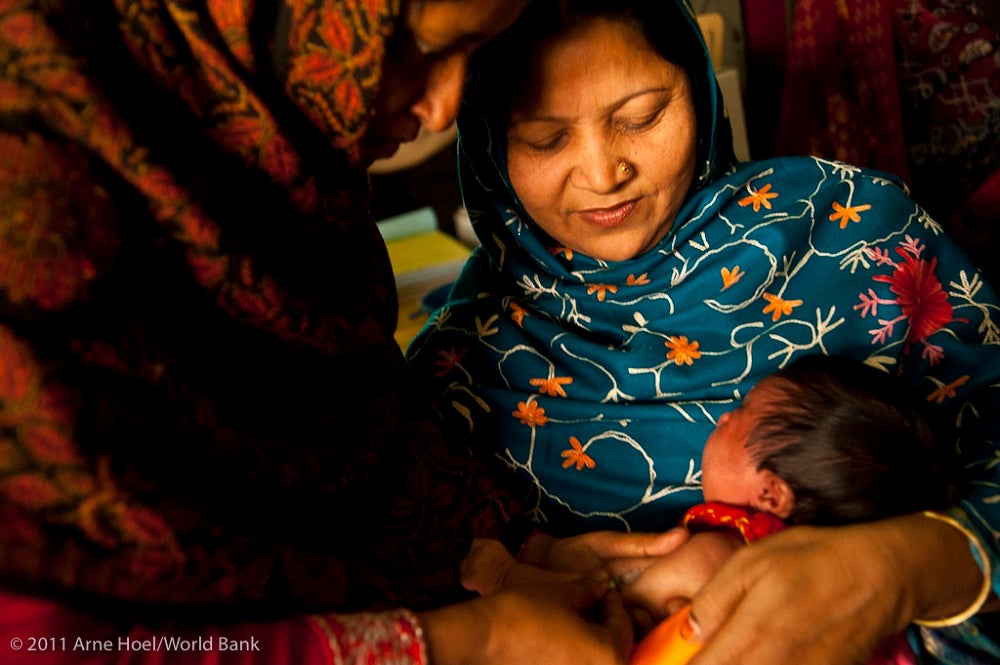 In Bangladesh, the proportion of stunted children under five fell from 43 to 31 percent between 2007 and 2018. Photo: World Bank
In Bangladesh, the proportion of stunted children under five fell from 43 to 31 percent between 2007 and 2018. Photo: World Bank
Bangladesh has made remarkable progress in reducing undernutrition. The proportion of stunted children under five fell from 43 to 31 percent between 2007 and 2018 while wasting in children nearly halved – from 17 percent in 2007 to 8 percent in 2018. Yet much remains to be done as a third of all children in Bangladesh under the age of five are stunted, and nearly one in five women are underweight. Additionally, poor nutrition of adolescent girls and pregnant mothers impacts the growth and development of their children, trapping them in a cycle of undernutrition.
The World Bank-financed Nuton Jibon Livelihood Improvement Project (NJLIP) is a multisectoral program, implemented in southern Bangladesh, which aims to alleviate poverty by fostering economic resilience through funding small infrastructure and livelihood support, empowering women, and providing knowledge on agricultural production. It has also helped create awareness about maternal and child nutrition at the individual and community level using social and behavior change communication tools.
How effective was the program?
A recent evaluation by the International Centre for Diarrheal Disease Research, Bangladesh (icddr,b) showed that the NJLIP has improved nutrition practices among women and children. Program participation led to a lower proportion of underweight children under five years in NJLIP households (15.7 percent) compared to the 18.5 percent among the non-NJLIP households. Pregnant mothers in NJLIP areas, on average, weighed 1.3 kg more during each trimester, and the prevalence of anemia was also lower among the NJLIP households (61.7 percent) compared to the non-NJLIP households (72.3 percent).
So, what led to these improvements? The evaluation notes that nutrition knowledge support services provided by NJLIP such as information on infant and young child feeding practices and appropriate nutrition practices during pregnancy, to a large extent, resulted in positive outcomes:
- Early initiation of breastfeeding increased among women in NJLIP households- reportedly 80 percent, in contrast to 70 percent among women in non-NJLIP households. Similarly, 81 percent of women were more likely to exclusively breastfeed during the first six months in comparison to 73 percent in non-NJLIP households.
- Adoption of age-appropriate complementary feeding practices in terms of quality and quantity of foods fed to young children was 53 percent among NJLIP households versus 36 percent in non-NJLIP households.
- Evidence suggests that adhering to optimal breastfeeding and age-appropriate complementary feeding practices positively impacts children’s nutrition.
- Children from NJLIP households, on average, consumed more protein, dairy, and vitamin A‐rich fruits than their counterparts in non-NJLIP households. Exposure to information and services helped increase the utilization of antenatal care services, consumption of iron folic acid and calcium supplements, and improved dietary diversity. These cumulatively led to improved nutrition of pregnant women from NJLIP households.
- Other components such as increased knowledge of water, sanitation, and hygiene (WASH) practices, livelihood development training and engagement in income generating activities further supported improving nutrition outcomes. Women in project households reported having more control over money and felt empowered in terms of decision-making regarding small purchases, particularly while buying food for their children.
"I lost all my hopes to survive, but nowadays, I don't have to starve. I have plenty for three full meals a day along with some assets,” says Halima Begum, a single mother of three and beneficiary of the NJLIP. Using the BDT 5000 grant she received from the program, she bought some livestock and developed a successful microenterprise.
COVID-19 has eroded many of these gains. In addition to significantly reducing the uptake of antenatal care services, gains made in food security and dietary diversity for pregnant women and children were also diminished to a large extent. The pandemic reduced the proportion of NJLIP children consuming meat or fish from 64.6 to 58.8 percent. Similarly, the proportion of women receiving iron and folic acid tablets as a part of their antenatal care reduced from 39 to 21 percent. However, the evaluation identified some protective effects of the program. For example, while the proportion of underweight children among the non-NJLIP households increased during the pandemic, no discernible change was observed among NJLIP children.
Moving to scale
This program offers several important learnings. First, the multisectoral nutrition-sensitive approach is effective in addressing an issue like undernutrition. Not only does the dissemination of key nutrition focused messages play a role in improving nutrition, additional support through income generation and empowerment of women in addressing undernutrition can provide a buffer against extenuating circumstances such as the COVID-19 pandemic.
Nutrition sensitive programs like the NJLIP, that combine nutrition with other multisectoral needs, should be scaled up nationally to improve nutrition outcomes for mothers and their children. Given its success, the World Bank will continue to support efforts to address undernutrition through the recently approved Resilience, Entrepreneurship and Livelihood Improvement Project, that adopts NJLIP’s multisectoral approach to address undernutrition in 3,200 villages in the country. However, measures need to be explicitly planned to ensure sustained access to essential health and nutrition information and services, and income support to address current and post-pandemic impacts.







Join the Conversation